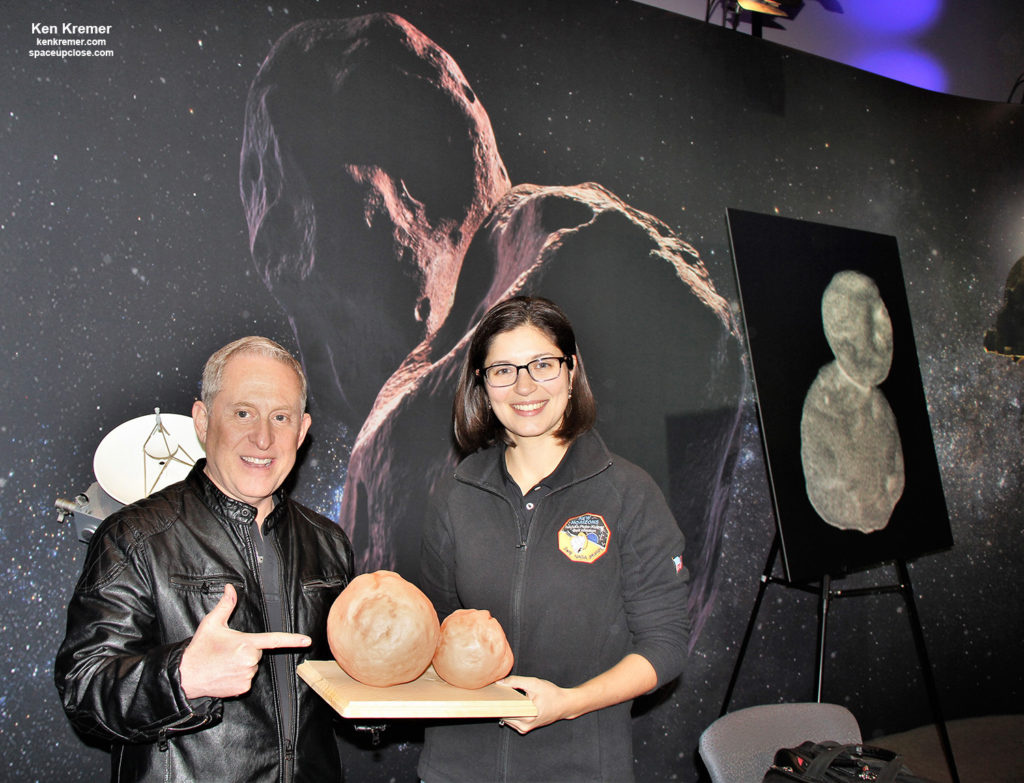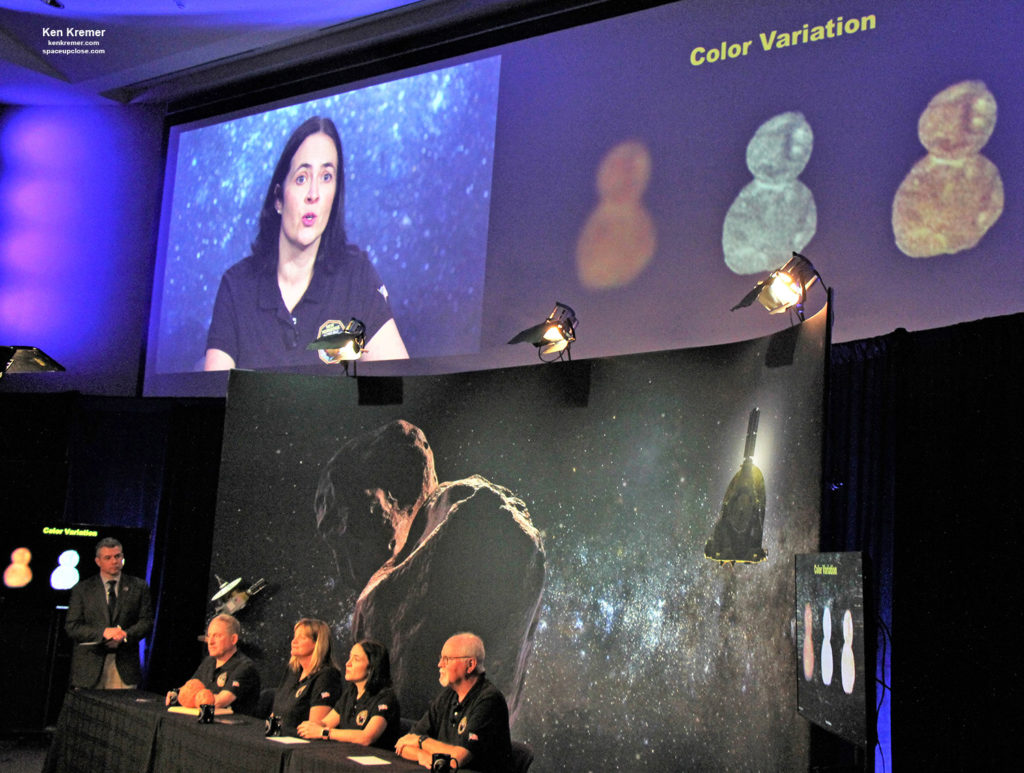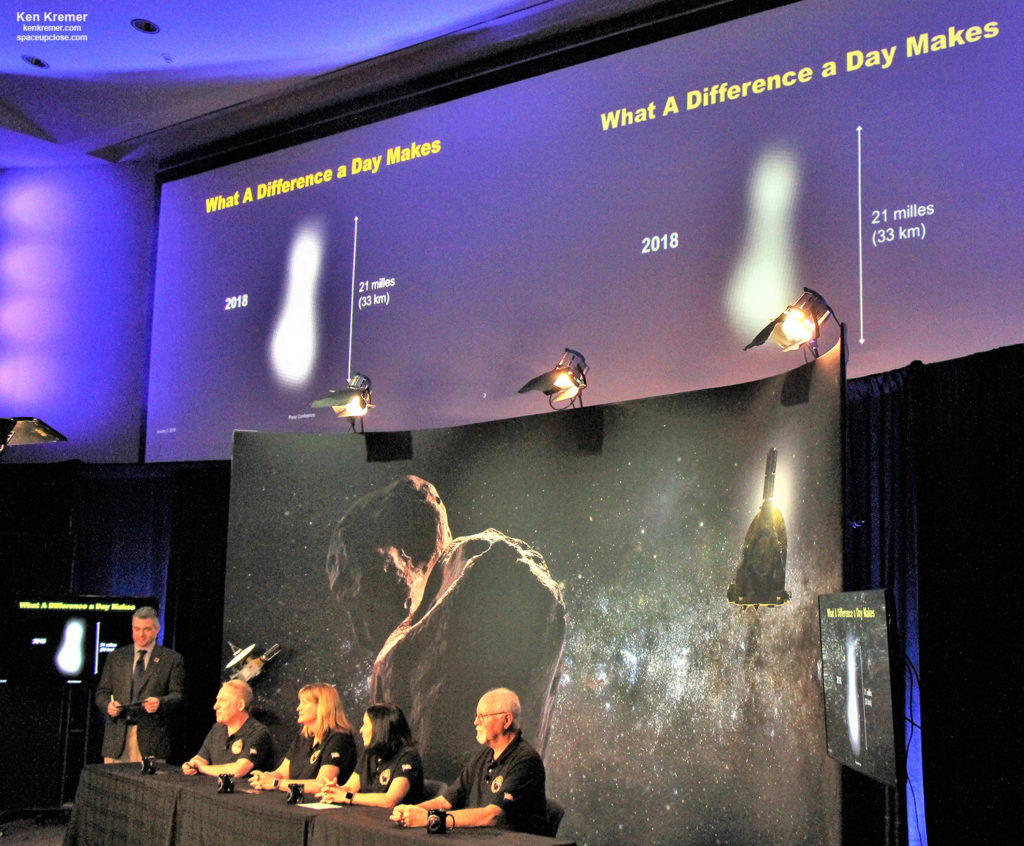RocketSTEM –2 January 2019
JOHNS HOPKINS UNIVERISTY
APPLIED PHYSICS LABORATORY, LAUREL, MD – Breathtaking new images taken by NASA’s New Horizons spacecraft during a New Year’s Day flyby yesterday unveil the tiny
‘Ultima Thule’ rock target as the most primitive solar system object ever seen
up close in addition to being the farthest object ever visited by a spaceship
from Earth – more than 4 billion miles away!
The new high
resolution images released today by the New Horizons team and NASA reveal the
object nicknamed ‘Ultima Thule’ to be a ‘contact binary’ connected by a very narrow
neckline – and not two distinct bodies.
“Ultima Thule” is
an unchanged fossil remnant formed during the dawn of our solar system some 4.5
Billion Years ago and counts as the first planetesimal ever seen, imaged and
visited up close. It’s a cold virtually unaltered body formed during the birth of the solar system.
“Meet Ultima Thule!” said New Horizons Principal
Investigator Alan Stern of the Southwest Research Institute in Boulder,
Colorado, at todays (Jan. 2) post flyby media briefing as he showed the photo a
cheering crowd erupting in applause at Johns Hopkins University Applied Physics
Laboratory (JHU APL), in Laurel, MD.
“Just like with Pluto, we could not be
happier. What you’re seeing is the first contact binary ever explored by spacecraft.
It’s two completely separate objects that are now joined together.”
Planetesimals are
the tiny building blocks from which much larger structures like moons and
planets are born by accretion of hordes of bits of matter over time.
The bi-lobal rock is shaped remarkably like a ‘snowman’ and
consists of two connected balls roughly spherical in appearance.
The new world measures 19 miles (31 kilometers) in length.
The team has unofficially nicknamed the larger sphere “Ultima” (12
miles/19 kilometers across) and the smaller sphere “Thule” (9
miles/14 kilometers across).
These new images taken by the Long-Range Reconnaissance Imager (LORRI) are the first
detailed images of the most distant object ever explored — the Kuiper Belt
object nicknamed Ultima Thule – which means “beyond the borders of the known
world.”
“This flyby is a historic achievement,” said New
Horizons Principal Investigator Alan Stern of the Southwest Research Institute
in Boulder, Colorado, at todays (Jan. 2) post flyby media briefing.
“Never before has any spacecraft team tracked down such a
small body at such high speed so far away in the abyss of space. New Horizons
has set a new bar for state-of-the-art spacecraft navigation.”
The new images were
taken from as close as 17,000 miles (27,000 kilometers) as New Horizons was approaching
at a velocity of 32,000 mph (9 miles per second).
The baby grand shaped new horizons spacecraft flew
within at a distance of merely 2,200 miles (3,500
kilometers).
Closest approach came just past midnight Tuesday shortly after
the dawn of New Year’s Day 2019 at 12:33 a.m. EST as mission scientists,
invited guests and the media including Space UpClose were on hand to witness
the groundbreaking events first hand as they unfolded at the Johns Hopkins University
Applied Physics Laboratory (JHU APL), in Laurel, MD.
Check out our
gallery of on site images from JHU APL throughout the flyby and close encounter
period.
“It’s a snowman,” said Stern as he revealed the first resolved
images of Ultima Thule.
“What a difference a day makes!” he remarked as he unveiled the 1st ever planetesimal seen up close by humanity compared
to the pixelated fuzzy blob seen in
every prior image through Dec. 30 – New Years Eve Eve.
It has remained pristine from the dawn of the formation of
our solar system.
“Its the first contact binary ever explored and we could not
be happier.”
The team also released the first color image which showed it
to have a reddish cast- possibly from frozen organic materials mixed with water,
methane and nitrogen ices.
The first composition data is expected back tonight and will
be revealed at tomorrow’s Jan. 3 media briefing along
with 3D and more color images.
crater-like features visible that may be confirmed or not when higher resolution images
reach earth next week.
Communications with the spacecraft will be interrupted a few days after it enters solar conjunction from around Jan 4 to 9. Transmission will restart when the ship reemerges from behind the sun.
“New Horizons is like a time machine, taking us back to
the birth of the solar system. We are seeing a physical representation of the
beginning of planetary formation, frozen in time,” said Jeff Moore, New
Horizons Geology and Geophysics team lead at today’s briefing.
“Studying Ultima Thule is helping us understand how
planets form — both those in our own solar system and those orbiting other stars
in our galaxy.”
“We
think what we’re looking at is perhaps the most primitive object that has yet
been seen by any spacecraft and may represent a class of objects which are the
oldest and most primitive objects that can be seen anywhere in the present
solar system.”
“Its remarkable appearance, unlike anything we’ve seen
before, illuminates the processes that built the planets four and a half
billion years ago,” says the team.
Moore said that
the two spheres likely joined as early as 99 percent of the way back to the
formation of the solar system, colliding no faster than two cars in a
fender-bender at perhaps just a few MPH.
“What we think we’re looking at is the
end product of a process which probably took place in only a few hundred
thousand or maybe a few million years at the very beginning of the formation of
the solar system,” Moore
explained.
“Its the first planetesimal
we’ve ever explored up close.”
The albedo is very
low varying between 6 to 13%. The remarkable neck is the brightest area,
perhaps 5 miles in width.
Overall it’s as dark
as potting soil.
 |
|
Credit: Ken
Kremer/kenkremer.com/spaceupclose.com |
New
Horizons has been hurtling towards the unexplored outer limits of our Solar
System since launching 13 years ago in Jan. 2006 and conducting the first up
close flyby of Pluto – the ninth planet – in July 2015.
Pluto, the largest known body in the Kuiper
Belt, was the first target explored by New Horizons during a fast flyby over three
years ago during July 2015.
‘Ultima Thule’ is the second Kuiper Belt object that has now
been explored up close by New Horizons.
The small icy rock in the Kuiper Belt is located some 1 Billion
miles (1.6 Billion km) beyond Pluto and orbits 4.1 Billion miles (6.6 Billion
km) from the Sun and the Earth .
for the spacecrafts second flyby target on New Year’s Day 2019 – “symbolizing this ultimate exploration by NASA” says Alan
Stern, the missions team leader and chief scientist.
world – officially known as 2014 MU69 – has now become
the farthest object ever explored up close by a manmade emissary in history when
NASA’s New Horizons spaceship zoomed past for a close encounter on Jan. 1, 2019 orbiting more than a billion miles beyond
Pluto, the most distant planet in our Solar System.
first ever up close examination of this distant object holds critical clues to
the formation of the outer solar system eons ago.
says New Horizons spacecraft is performing perfectly and all systems and
subsystems are just as good as the day they were launched in Jan. 2006 on a ULA
Atlas V rocket.
has enough power to operate through the mid-2030’s at least and can conduct a
third flyby.
The
team says they will begin that search immediately using the LORRI camera and
propose an extended mission to NASA in the summer of 2020.
Watch
for Ken’s continuing onsite coverage direct from JHU APL.
Watch
for Ken’s continuing onsite coverage of NASA, SpaceX, ULA, Boeing, Lockheed Martin,
Northrop Grumman and more space and mission reports direct from the Kennedy Space
Center, Cape Canaveral Air Force Station, Florida and Wallops Flight Facility,
Virginia.
Stay tuned here for Ken’s continuing Earth and Planetary science
and human spaceflight news: www.kenkremer.com –www.spaceupclose.com – twitter
@ken_kremer – email: ken at kenkremer.com
Dr. Kremer is a research scientist,
journalist and photographer based in the KSC area.
Ken’s photos are for sale and he is available for lectures and outreach events










